A) A price ceiling reduces the quantity exchanged on the market, but a price floor increases the quantity exchanged on the market.
B) A price ceiling increases the quantity exchanged on the market, but a price floor decreases the quantity exchanged on the market.
C) Both price floors and price ceilings reduce the quantity exchanged in the market.
D) Both price floors and price ceilings increase the quantity exchanged in the market.
Correct Answer

verified
Correct Answer
verified
Multiple Choice
If a good has a perfectly inelastic short-run supply curve, an increase in demand will:
A) increase the price and quantity exchanged in the short run.
B) increase the price and but leave the quantity exchanged the same in the short run.
C) increase the quantity exchanged but leave the price the same in the short run.
D) leave both price and quantity exchanged the same in the short run.
Correct Answer

verified
Correct Answer
verified
Multiple Choice
Exhibit 4-A 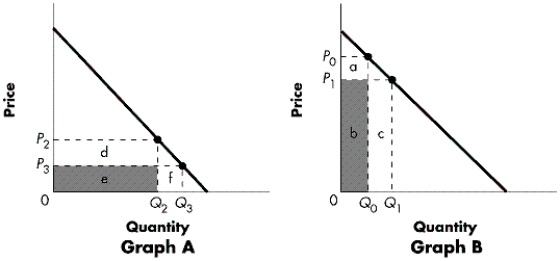 -Refer to Exhibit 4-A.Elasticity varies along a linear demand curve.Graph B represents the section of the curve where:
-Refer to Exhibit 4-A.Elasticity varies along a linear demand curve.Graph B represents the section of the curve where:
A) the curve is elastic.
B) Ed is > 1.
C) starting at P1, an increase in price will lead to a decrease in total revenue.
D) all of the above are correct.
E) none of the above are correct.
Correct Answer

verified
Correct Answer
verified
Multiple Choice
Which of the following is not a result of rent controls?
A) reduced incentives to build new rental housing
B) reduced incentives for landlords to keep rental units in good repair
C) increased discrimination against people deemed undesirable on the part of landlords
D) increased turnover as tenants move more frequently from one rental unit to another
Correct Answer

verified
Correct Answer
verified
Multiple Choice
Exhibit 4-C 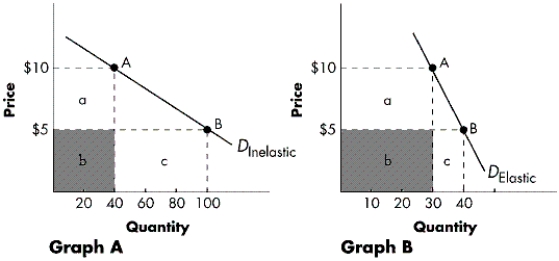 -Refer to Exhibit 4-C.Graph B represents a demand curve that is relatively ____.Total revenue ____ as the price decreases from $10 to $5.
-Refer to Exhibit 4-C.Graph B represents a demand curve that is relatively ____.Total revenue ____ as the price decreases from $10 to $5.
A) inelastic; decreases
B) elastic; decreases
C) elastic; increases
D) inelastic; increases
Correct Answer

verified
Correct Answer
verified
Multiple Choice
To the extent that a governmental price control succeeds in affecting price, it can be expected to lead to a corresponding:
A) reduction in the volume of sales only if the price is forced down.
B) reduction in the volume of sales if the price is forced down and an increase in the volume of sales if the price is forced up.
C) decrease in the volume of sales whether the price is forced up or down.
D) increase in the volume of sales whether the price is forced up or down.
Correct Answer

verified
Correct Answer
verified
Multiple Choice
A tax is imposed on orange juice.Consumers will bear the full burden of this tax if the:
A) price elasticity of demand for orange juice equals 1.4.
B) demand for orange juice is perfectly elastic.
C) demand for orange juice is unit elastic.
D) supply curve for orange juice is perfectly inelastic.
E) price elasticity of demand for orange juice equals 0.6.
Correct Answer

verified
Correct Answer
verified
Multiple Choice
Whenever a price ceiling is imposed in a market, it is true that:
A) quantity demanded exceeds quantity supplied and a surplus results.
B) quantity demanded exceeds quantity supplied and a shortage results.
C) quantity supplied exceeds quantity demanded and a surplus results.
D) quantity supplied exceeds quantity demanded and a shortage results.
E) it is necessary to know whether the ceiling is imposed above or below the equilibrium price in order to determine whether the quantity traded will be affected.
Correct Answer

verified
Correct Answer
verified
Multiple Choice
Figure 4-D 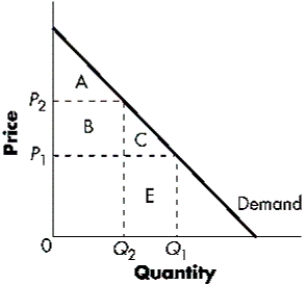 -Refer to Figure 4-D.When the price is P1, the consumer surplus is equal to the area:
-Refer to Figure 4-D.When the price is P1, the consumer surplus is equal to the area:
A) A.
B) C.
C) A + B.
D) A + B + C.
Correct Answer

verified
Correct Answer
verified
Multiple Choice
The area between the market price and the supply curve provides a measure of:
A) consumer surplus.
B) producer surplus.
C) consumer surplus plus producer surplus.
D) marginal utility.
E) the deadweight loss arising from free trade.
Correct Answer

verified
Correct Answer
verified
Multiple Choice
A perfectly elastic supply curve is:
A) upward sloping to the right.
B) downward sloping to the left.
C) horizontal.
D) vertical.
E) any of the above.
Correct Answer

verified
Correct Answer
verified
Multiple Choice
Figure 4-A
The diagram below represents the market for butter. 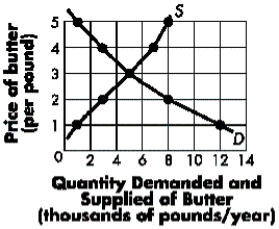 -Refer to Figure 4-A.If a price ceiling of $4 is imposed, we would expect that ____ units of butter will be sold.
-Refer to Figure 4-A.If a price ceiling of $4 is imposed, we would expect that ____ units of butter will be sold.
A) 7,000
B) 5,000
C) 4,000
D) 3,000
E) 2,000
Correct Answer

verified
Correct Answer
verified
Multiple Choice
Based on the graph below, what is the consumer surplus of the 10th unit bought/sold? 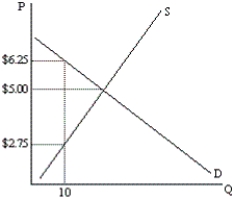
A) $1.25
B) $2.25
C) $2.75
D) $3.50
E) $6.25
Correct Answer

verified
Correct Answer
verified
Multiple Choice
Table 4-D Miles demands jazz CDs according to the following demand schedule: -Refer to Table 4-D.If the price of jazz CDs equals $20, the consumer surplus Miles receives from purchasing jazz CDs is:
A) $10.
B) $15.
C) $20.
D) $55.
E) $75.
Correct Answer

verified
Correct Answer
verified
Multiple Choice
If the supply curve is perfectly elastic, then an increase in demand will:
A) increase both the price and the quantity exchanged.
B) increase the price but result in no change in the quantity exchanged.
C) increase the quantity exchanged but result in no change in the price.
D) decrease the price but not change the quantity exchanged.
E) do none of the above.
Correct Answer

verified
Correct Answer
verified
Multiple Choice
Figure 4-C 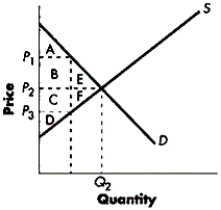 -Refer to Figure 4-C.If the market price equals P2, producer surplus can be identified in the diagram as area:
-Refer to Figure 4-C.If the market price equals P2, producer surplus can be identified in the diagram as area:
A) A + B + E.
B) B + E.
C) D.
D) C + D+ F.
E) C + F.
Correct Answer

verified
Correct Answer
verified
Multiple Choice
Gains from trade are measured by:
A) consumer surplus.
B) producer surplus.
C) the sum of consumer and producer surplus.
D) producer surplus minus consumer surplus.
Correct Answer

verified
Correct Answer
verified
Multiple Choice
Which of the following is not likely to result from an increase in the federal minimum wage?
A) an increase in the quantity of low-skilled labor supplied
B) a decrease in the quantity of low-skilled labor demanded
C) a decrease in teenage unemployment
D) an increase in teenage unemployment
Correct Answer

verified
Correct Answer
verified
Multiple Choice
If the measured elasticity of supply coefficient equals 0.6, then supply is:
A) perfectly elastic.
B) elastic.
C) unit elastic.
D) inelastic.
E) perfectly inelastic.
Correct Answer

verified
Correct Answer
verified
Multiple Choice
If the demand is perfectly elastic, what would happen to the quantity demanded if there is a tiny increase in price?
A) quantity demanded will increase proportionately
B) quantity demanded will fall to zero
C) quantity demanded will register a disproportionately high increase
D) quantity demanded will decrease proportionately
E) quantity demanded will remain the same
Correct Answer

verified
Correct Answer
verified
Showing 201 - 220 of 248
Related Exams